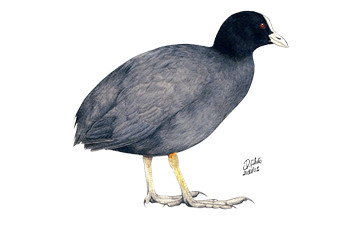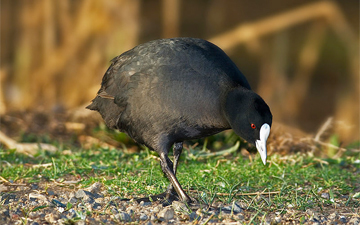The Eurasian Coot, Fulica atra, also known as Coot, is a member of the rail and crake bird family, the Rallidae. The Australian subspecies is known as the Australian Coot.
Distribution
The Coot breeds across much of the Old World on freshwater lakes and ponds. It occurs and breeds in Europe, Asia, Australia, and Africa. The species has recently expanded its range into New Zealand. It is resident in the milder parts of its range, butmigrates further south and west from much of Asia in winter as the waters freeze.
Description
The Coot is 36–42 cm long, and is largely black except for the white facial shield (which gave rise to the phrase “as bald as a coot”, which the Oxford English Dictionary cites in use as early as 1430). As a swimming species, the Coot has partial webbing on its long strong toes.
The juvenile is paler than the adult, has a whitish breast, and lacks the facial shield; the adult black plumage develops when about 3–4 months old, but the white shield is only fully developed at about one year old.
This is a noisy bird with a wide repertoire of crackling, explosive, or trumpeting calls, often given at night.
(From Wikipedia.org, July 15 2010)
– – –
The coot feeds on pondweeds and invertebrates (4); it dives rather clumsily to obtain food, and returns to the surface rapidly thanks to its cork-like buoyancy (6). Unlike ducks, coots bring their food to the surface before eating it; this results in frequent cases of food stealing (4). They are opportunistic birds, and may feed in grasslands at certain times of the year (6). During winter, large flocks may gather on large lakes and reservoirs (10), these gatherings are relatively peaceful compared to the fierce territorial aggression seen during the breeding season (2). The nest, a mound of dead reeds, is usually built amongst emergent vegetation (6). From mid-March, between 6 and 9 speckled eggs are laid (occasionally up to 15 eggs, though these large clutches may be laid by more than one female (10)). The eggs are incubated by both parents for up to 24 days (6). The chicks leave the nest a few days after hatching, and reach independence at around 8 weeks of age (6). Two broods are produced a year, but occasionally a third brood may occur (6).
(From Arkive via The Encyclopedia of Life, July 15 2010)
– – –





